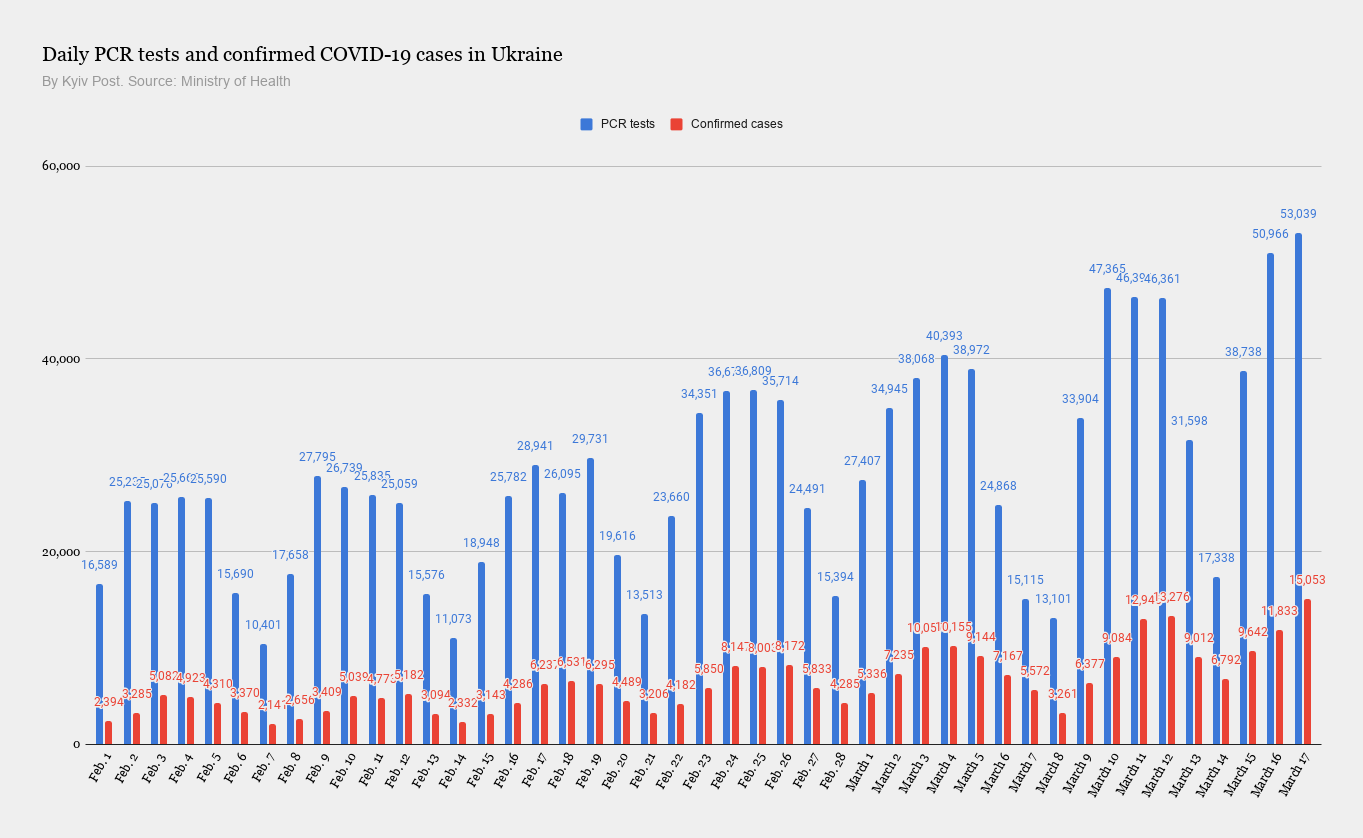Ukraine has registered 15,053 new cases of COVID-19 as of 9 a.m. on March 18. This is the highest figure since Nov. 27 when the country detected 16,294 new coronavirus cases.
The total number of cases in the country since the start of the pandemic is more than 1.5 million. There are currently 230,633 active cases in Ukraine.
In the past 24 hours, 6,514 COVID-19 patients have recovered and 267 have died. Over 1.24 million people have recovered from COVID-19 and 29,253 have died since the pandemic hit Ukraine.
In the past 24 hours, 4,376 people have been hospitalized with COVID-19.
Ukrainian laboratories have carried out 53,039 polymerase chain reaction (PCR) tests, 21,782 antibody tests and 43,959 rapid antigen tests in the past day. Over 7.5 million PCR tests have been conducted in Ukraine since the start of the pandemic.

Ukraine’s daily COVID-19 cases, deaths and recoveries from Feb. 1 to March 17. All data was released by the Ministry of Health.
The largest numbers of new cases have been recorded in Zhytomyr Oblast (1,398), Lviv Oblast (1,092), the city of Kyiv (1,092), Odesa Oblast (997), and Khmelnytskyi Oblast (800).
Vaccination in Ukraine began on Feb. 27 and by March 18, a total of 81,755 people have received the first dose of the AstraZeneca vaccine produced by India’s Serum Institute. One person has received 2 doses.
In the past 24 hours, the largest number of vaccinations was recorded in the city of Kyiv (840), Kyiv Oblast (670), Donetsk Oblast (620) and Lviv Oblast (610).
To date, Ukraine has received 500,000 doses of vaccine produced by India’s Serum Institute. Ukraine has ordered a total of 17 million doses from India, including vaccines developed by British-Swedish pharmaceutical AstraZeneca and U.S. biotech firm Novavax. Altogether, Ukraine expects to receive around 22 million doses in 2021.
On March 1, the Health Ministry started accepting online and telephone applications from Ukrainians who want to be put on the waiting list for the vaccine. Over 250,000 people signed up as of March 14.
Health Minister Maksym Stepanov said that Ukraine’s vaccination drive is unacceptably slow and he will personally intervene. The government had planned for 10,000 vaccinations per day in the first weeks, while in reality, the pace is 5-10 times slower.

Ukraine’s daily new COVID-19 cases and polymerase chain reaction (PCR) tests, the most accurate way of diagnosing the novel coronavirus, between Feb. 1 and March 17. All data was released by the Ministry of Health. (Kyiv Post)
Meanwhile, Ukraine remains in adaptive quarantine, where each oblast is assigned one of four epidemiological levels, depending on the COVID-19 situation there. There are green, yellow, orange and red levels. A red status means that a lockdown will be imposed locally.
The Ministry of Health has designated the city of Kyiv as “orange” on March 6.
Cities in the orange zone must order clubs and restaurants to shut down at night. Furthermore, 50% of seats at restaurants must be empty, and museums, libraries, and shopping centers must have no more than one person per 10 square meters.
Currently, most cafes and restaurants that are crowded during the day and in the evenings, close before midnight.
Four regions are now in the red zone, including Zhytomyr, Ivano-Frankivsk, Chernivtsy and Zakarpattia. They have had to shut down all entertainment businesses and restaurants until further notice because of spikes in the numbers of cases.
During his morning briefing on March 16, Health Minister Maksym Stepanov said that Kyiv and Vinnytsia Oblast could soon be declared red zones.
According to a law passed by the government on Jan. 13, businesses have to refuse to service any customer who’s not wearing a mask and call the police if the person refuses to put it on. A mask has to cover both the nose and mouth.
On March 4, Prime Minister Denys Shmyhal said Ukraine has entered the third wave of the COVID-19 pandemic. The prime minister didn’t rule out the possibility of another nationwide lockdown. Ukraine has had two lockdowns: in March-May 2020, and in January 2021.
